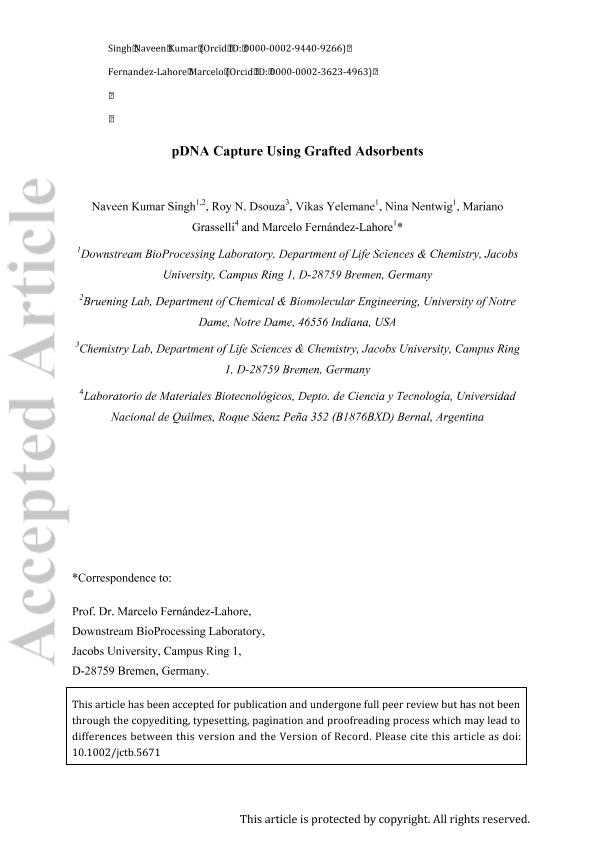Artículo
pDNA capture using grafted adsorbents
Singh, Naveen Kumar; Dsouza, Roy N.; Yelemane, Vikas; Nentwig, Nina; Grasselli, Mariano ; Fernández Lahore, Marcelo
; Fernández Lahore, Marcelo
 ; Fernández Lahore, Marcelo
; Fernández Lahore, Marcelo
Fecha de publicación:
07/2018
Editorial:
John Wiley & Sons Ltd
Revista:
Journal of Chemical Technology and Biotechnology
ISSN:
0268-2575
Idioma:
Inglés
Tipo de recurso:
Artículo publicado
Clasificación temática:
Resumen
BACKGROUND: ‘Expanded’ composite materials are of interest as an alternative, or as a supplement, to packed-bed chromatography during bioproduct recovery and purification. Functionalized non-woven fabrics and mega-porous bodies are examples of systems that showed promise. However, there is scarce information on their suitability to capture and release plasmid DNA (pDNA), an important type of product employed in gene therapy. RESULTS: Composite adsorbents were prepared using either chemical (CG-DEAE-NW) or gamma-irradiated graft-polymerization (GIR-DEAE-MP), and subsequently modified to have diethylamino ethanol (DEAE) functionality. Capture experiments showed that pDNA can actually reversibly bind to the two mentioned adsorbents, with capacity values of 2.4 and 1.3 mg per mL, respectively. These values are in the range of what can be expected from commercial beaded adsorbents but lower that the values expected from monoliths. CONCLUSIONS: Expanded materials, due to their high voidage, may present limited capacity for pDNA. However, such materials are able to bind proteins and other contaminants from bacterial lysate, opening the way for their utilization in the ‘negative’ mode.
Palabras clave:
EXPANDED ADSORBENTS
,
DNA PURIFICATION
,
GENE THERAPY
,
CHROMATOGRAPHY
Archivos asociados
Licencia
Identificadores
Colecciones
Articulos(CCT - LA PLATA)
Articulos de CTRO.CIENTIFICO TECNOL.CONICET - LA PLATA
Articulos de CTRO.CIENTIFICO TECNOL.CONICET - LA PLATA
Articulos(IMBICE)
Articulos de INST.MULTIDISCIPL.DE BIOLOGIA CELULAR (I)
Articulos de INST.MULTIDISCIPL.DE BIOLOGIA CELULAR (I)
Citación
Singh, Naveen Kumar; Dsouza, Roy N.; Yelemane, Vikas; Nentwig, Nina; Grasselli, Mariano; et al.; pDNA capture using grafted adsorbents; John Wiley & Sons Ltd; Journal of Chemical Technology and Biotechnology; 93; 7; 7-2018; 1975-1979
Compartir
Altmétricas



